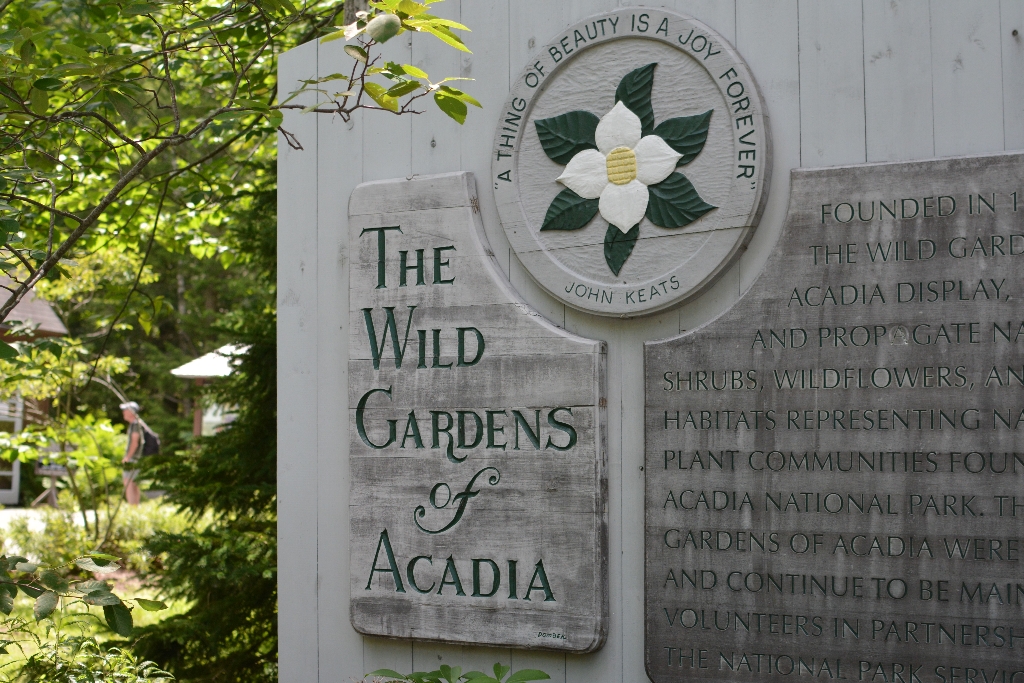
At the Wild Gardens of Acadia, you can see over 400 native plant species in thirteen sections designed to represent natural plant communities found within Acadia National Park. Habitats such as mountain, heath, seaside, coniferous forest, and nine others are represented. The gardens serve as a living field guide and educational resource to familiarize one with native vegetation. All plants are labeled and grouped by habitat. The gardens are open seasonally every morning until dusk. There is no additional fee to view the gardens; you only need your park entrance pass.
History of Wild Gardens of Acadia
In the early 1900s, Charles W. Eliot and George B. Dorr recognized the natural beauty of Mount Desert Island and the need for its preservation. Dorr purchased the Sieur de Monts Spring area in 1909 and named it the Wild Gardens of Acadia.
On July 8, 1916, Sieur de Monts National Monument was established, and at this time encompassed 6,634 acres, including four lakes and ten mountains, within a contiguous boundary. George Dorr was appointed the park’s first superintendent, and that same year formally established the Wild Gardens of Acadia Corporation to acquire land for public use and for educational study and scientific research. He placed his private holdings in the corporation which included the Sieur de Monts Spring parcel and much of the Great Meadow, with the
intention of donating them to the monument at a future date. Notably, the monument’s boundary did not include the Tarn, which had been transferred to the Trustees in May of the previous year.
In 1918, the Wild Gardens of Acadia was recognized by the American Society of Landscape Architects. The following year, on February 16, 1919, Sieur de Monts National Monument became Lafayette National Park. Over the years, Dorr had apparently begun surveys for a “garden approach” to the entire Sieur de Monts Spring area. This approach corresponds to a 1926 donation of a north-south linear tract of land (Tract 11-114) that was conveyed from the Wild Gardens of Acadia Corporation, Sieur de Monts Spring Company, and George Dorr to the U.S. Government on May 1, 1926.
On August 11, 1930, Tracts 11-113 (120.3 acres) and 11-120 (25.7 acres) encompassing the Great Meadow and the Sieur de Monts Spring area were transferred from George Dorr and the Wild Gardens of Acadia Corporation to John D. Rockefeller, Jr. Land and easements associated with the Museum property, Tract 11-121 (2.3 acres), were transferred from the Sieur de Monts Spring Company to Lafayette National Park Museum of Stone Age Antiquities on July 22, 1930. On August 12, 1930, this same land and easements, and the right for
expansion, was conveyed to the U.S. Government. Nearby, Tract 12-107 (32 acres) that encompassed the Tarn was transferred from the HCTPR to the U.S. Government on July 22, 1931 (Land Ownership Record, 1944).
Over time, various attempts by Dorr and others led to multiple plans for paths and gardens in this area. In 1961, Superintendent Harold A. Hubler offered space to the Bar Harbor Garden Club to develop an exhibition garden dedicated to the display and propagation of the island’s native wild flowers. The gardens and their winding gravel paths were laid out just north of the spring building [Nature Center] amongst “a tangle of maples and blackberries” damaged in the 1947 fire. The project gestured to the many wild gardens plans envisioned by George Dorr. As part of the arrangement, the park agreed to maintain the irrigation system and provide supplies. In 1985, the Wild Gardens of Acadia was acknowledged as a “Significant Contribution to Horticulture” by the Garden Club of America.
In 2010, the Wild Gardens of Acadia became an official committee of Friends of Acadia and formalized this new standing through a partnership with Friends of Acadia and Acadia National Park—ensuring continued success and support from the park as an educational resource. The Wild Gardens of Acadia committee received the park's Partnership Award in 2011 in recognition of the “Wild Gardens of Acadia Volunteers for 50 years of devoted stewardship” from the National Park Service.
Is there something we missed for this itinerary?
Itineraries across USA


















































